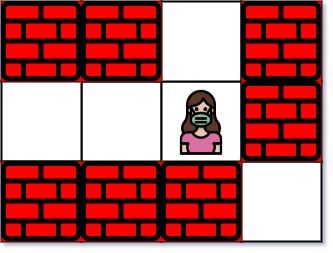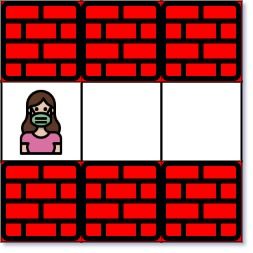| comments | difficulty | edit_url | rating | source | tags | |||
|---|---|---|---|---|---|---|---|---|
true |
Medium |
1638 |
Biweekly Contest 56 Q2 |
|
You are given an m x n matrix maze (0-indexed) with empty cells (represented as '.') and walls (represented as '+'). You are also given the entrance of the maze, where entrance = [entrancerow, entrancecol] denotes the row and column of the cell you are initially standing at.
In one step, you can move one cell up, down, left, or right. You cannot step into a cell with a wall, and you cannot step outside the maze. Your goal is to find the nearest exit from the entrance. An exit is defined as an empty cell that is at the border of the maze. The entrance does not count as an exit.
Return the number of steps in the shortest path from the entrance to the nearest exit, or -1 if no such path exists.
Example 1:
Input: maze = [["+","+",".","+"],[".",".",".","+"],["+","+","+","."]], entrance = [1,2] Output: 1 Explanation: There are 3 exits in this maze at [1,0], [0,2], and [2,3]. Initially, you are at the entrance cell [1,2]. - You can reach [1,0] by moving 2 steps left. - You can reach [0,2] by moving 1 step up. It is impossible to reach [2,3] from the entrance. Thus, the nearest exit is [0,2], which is 1 step away.
Example 2:
Input: maze = [["+","+","+"],[".",".","."],["+","+","+"]], entrance = [1,0] Output: 2 Explanation: There is 1 exit in this maze at [1,2]. [1,0] does not count as an exit since it is the entrance cell. Initially, you are at the entrance cell [1,0]. - You can reach [1,2] by moving 2 steps right. Thus, the nearest exit is [1,2], which is 2 steps away.
Example 3:
Input: maze = [[".","+"]], entrance = [0,0] Output: -1 Explanation: There are no exits in this maze.
Constraints:
maze.length == mmaze[i].length == n1 <= m, n <= 100maze[i][j]is either'.'or'+'.entrance.length == 20 <= entrancerow < m0 <= entrancecol < nentrancewill always be an empty cell.
We can start from the entrance and perform a breadth-first search (BFS). Each time we reach a new empty cell, we mark it as visited and add it to the queue until we find an empty cell on the boundary, then return the number of steps.
Specifically, we define a queue
If we finish the traversal without finding an empty cell on the boundary, we return
The time complexity is
class Solution:
def nearestExit(self, maze: List[List[str]], entrance: List[int]) -> int:
m, n = len(maze), len(maze[0])
i, j = entrance
q = deque([(i, j)])
maze[i][j] = "+"
ans = 0
while q:
ans += 1
for _ in range(len(q)):
i, j = q.popleft()
for a, b in [[0, -1], [0, 1], [-1, 0], [1, 0]]:
x, y = i + a, j + b
if 0 <= x < m and 0 <= y < n and maze[x][y] == ".":
if x == 0 or x == m - 1 or y == 0 or y == n - 1:
return ans
q.append((x, y))
maze[x][y] = "+"
return -1class Solution {
public int nearestExit(char[][] maze, int[] entrance) {
int m = maze.length, n = maze[0].length;
final int[] dirs = {-1, 0, 1, 0, -1};
Deque<int[]> q = new ArrayDeque<>();
q.offer(entrance);
maze[entrance[0]][entrance[1]] = '+';
for (int ans = 1; !q.isEmpty(); ++ans) {
for (int k = q.size(); k > 0; --k) {
var p = q.poll();
for (int d = 0; d < 4; ++d) {
int x = p[0] + dirs[d], y = p[1] + dirs[d + 1];
if (x >= 0 && x < m && y >= 0 && y < n && maze[x][y] == '.') {
if (x == 0 || x == m - 1 || y == 0 || y == n - 1) {
return ans;
}
maze[x][y] = '+';
q.offer(new int[] {x, y});
}
}
}
}
return -1;
}
}class Solution {
public:
int nearestExit(vector<vector<char>>& maze, vector<int>& entrance) {
int m = maze.size(), n = maze[0].size();
int dirs[5] = {-1, 0, 1, 0, -1};
queue<pair<int, int>> q;
q.emplace(entrance[0], entrance[1]);
maze[entrance[0]][entrance[1]] = '+';
for (int ans = 1; !q.empty(); ++ans) {
for (int k = q.size(); k; --k) {
auto [i, j] = q.front();
q.pop();
for (int d = 0; d < 4; ++d) {
int x = i + dirs[d], y = j + dirs[d + 1];
if (x >= 0 && x < m && y >= 0 && y < n && maze[x][y] == '.') {
if (x == 0 || x == m - 1 || y == 0 || y == n - 1) {
return ans;
}
maze[x][y] = '+';
q.emplace(x, y);
}
}
}
}
return -1;
}
};func nearestExit(maze [][]byte, entrance []int) int {
m, n := len(maze), len(maze[0])
q := [][2]int{{entrance[0], entrance[1]}}
maze[entrance[0]][entrance[1]] = '+'
dirs := []int{-1, 0, 1, 0, -1}
for ans := 1; len(q) > 0; ans++ {
for k := len(q); k > 0; k-- {
p := q[0]
q = q[1:]
for l := 0; l < 4; l++ {
x, y := p[0]+dirs[l], p[1]+dirs[l+1]
if x >= 0 && x < m && y >= 0 && y < n && maze[x][y] == '.' {
if x == 0 || x == m-1 || y == 0 || y == n-1 {
return ans
}
q = append(q, [2]int{x, y})
maze[x][y] = '+'
}
}
}
}
return -1
}function nearestExit(maze: string[][], entrance: number[]): number {
const dir = [0, 1, 0, -1, 0];
const q = [[...entrance, 0]];
maze[entrance[0]][entrance[1]] = '+';
for (const [i, j, ans] of q) {
for (let d = 0; d < 4; d++) {
const [x, y] = [i + dir[d], j + dir[d + 1]];
const v = maze[x]?.[y];
if (!v && ans) {
return ans;
}
if (v === '.') {
q.push([x, y, ans + 1]);
maze[x][y] = '+';
}
}
}
return -1;
}

